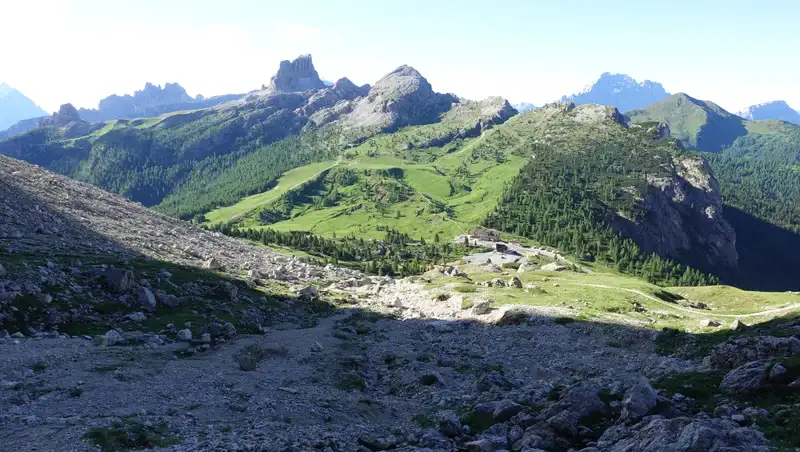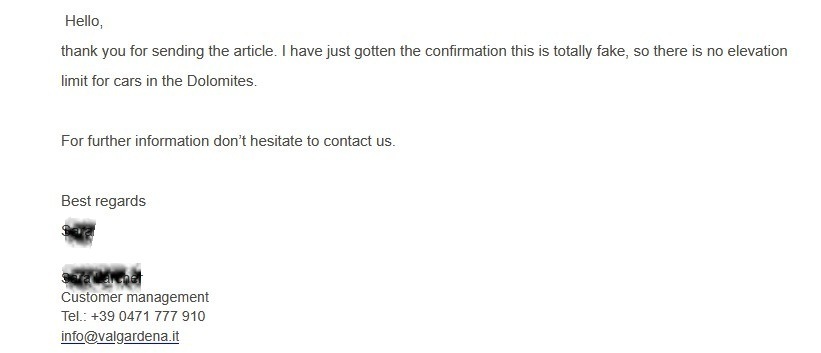There was a discussion recently on a FB group about the topic mentioned in the title, and all based on a question where the altitude quota is mentioned with a reference to a post published in a site.
I am not giving the link to the article due to the reasons that will be explained below. Also, the publication date of the article in the site (April 1) raises a slight possibility of it being an April Fool’s jest.

However, you can read the FB group discussion about this issue here.
But what this is about
Apparently, starting from June 2024, the South Tyrolean region of the Dolomites introduced a daily altitude quota for private motorized vehicles to promote sustainable tourism and protect the sensitive UNESCO-designated areas.
In short, this should be as follows:
Daily altitude quota: Each private vehicle is allowed a daily elevation gain of up to 3000 meters without charge.
Exceeding the quota: If a vehicle surpasses the 3000-meter limit, a fee of 0.005 € per additional meter is applied.
Purpose of the fees: Collected fees are allocated to enhance the Dolomites region, including building information points, expanding parking facilities, adding sanitary amenities, and increasing charging stations for electric vehicles.
A few comments here before I continue. First, it is not clear if this is only about ascent to high passes, or it includes descent as well.
Second, if it is about ascent only, it is still quite generous, but see a bit more below.
Implementation
Altitude measurement: Standardized measuring devices are provided to monitor elevation gains. Hotels issue these devices to their guests and handle the billing process, with the discretion to pass on costs.
My comment: I have not heard or read anywhere that such devices were offered by hotels to their guests.
Access for other travelers: Day visitors and travelers passing through can obtain the sensors at tourist information offices in larger valley resorts, ski lift valley stations, participating hotels, and petrol stations.
Billing can also occur at these locations. A smartphone app is planned to facilitate journey recording and secure payment in the future.
These measures aim to encourage conscious travel and reduce the environmental impact of individual mobility in the Dolomites.
Practical meaning
Let’s see about some details, supplemented by critical analysis and broader context, while addressing this specific topic.
For example, driving multiple high passes in a day could rack up significant elevation. Bolzano (262 m) to Passo Pordoi (2239 m) is 1977 m of gain, and adding a descent and another ascent (e.g., to Passo Sella at 2244 m) could push totals higher.
If the limit is 3000 meters of ascent, it might restrict ambitious itineraries, though descent isn’t explicitly mentioned. In environmental terms, regulating ascent makes sense, emissions and road wear increase with steep climbs, but descent limits seem less likely unless tied to safety or braking concerns.
But if you stay in any of the valleys below the famous passes, you can drive over a couple of them in one day without exceeding the mentioned limit. This assuming that descent is not calculated in, and because the valleys are not low. Take Alta Badia as one example, you are over 1600 meters of elevation at the valley floor which you start from.
Without official documentation (e.g., from Trentino-Alto Adige authorities or UNESCO), it is unclear if this is a hard cap or a guideline, and whether it is ascent-only or total elevation change.
Cross-referencing broader sources, no major Dolomites tourism or government websites (e.g., visitdolomites.com, visittrentino.info) confirm this altitude-specific rule as of March 11, 2025.
Existing restrictions, like those noted in 2023 by lerepairedesmotards.com, focus on low-emission zones, tolls, or periodic closures (e.g., cyclist-only days on Sella Pass), not daily elevation quotas.
The claim might reflect a proposal still in development, possibly misreported or exaggerated from discussions about sustainable tourism.
If real, it would likely apply to private cars broadly, not distinguishing ascent from descent unless specified, as regulations tend to simplify enforcement (e.g., tracking total elevation via GPS or pass checkpoints).
Is this real?
Well, keep reading, here is what I have done so far.
I posted a comment at the site where the initial information was published, if they give any reply, I shall add it here and perhaps give the link to the site with its article.
I also contacted several official addresses and asked for official confirmation. This was one of my emails sent to an address:

Here is one reply I received the same day, you can use the contact data to confirm:

Then I sent them the link to the article, and received this reply:

I think this should conclude the story, it was fake. But if I get any additional information, it will be added here so stay tuned.
Thank you for reading. If you know more about the topic discussed here please use the comment box below and let us know. Subscribe to my weakly newsletter and stay informed, the subscription form is given below.
Leave a Reply